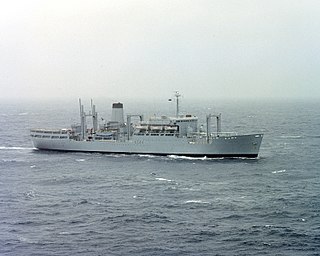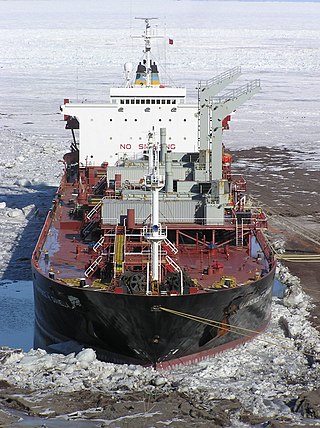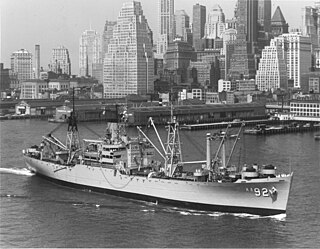
The Lewis and Clark class of dry cargo ship is a class of 14 underway replenishment vessels operated by the United States Navy's Military Sealift Command. The ships in the class are named after famous American explorers and pioneers.

RFA Stromness (A344) was a fleet stores ship which served the Royal Fleet Auxiliary until sold to the U.S. Navy's Military Sealift Command in 1983. While in the service of British forces, it saw service in the Falklands War. After the sale to the United States, it was renamed USNS Saturn (T-AFS-10) and acted as a combat stores ship until it was deactivated in 2009; it was able to supply two other ships at once. In 2010, it was sunk in an exercise by the U.S. Carrier Strike Group Two off the coast of North Carolina.

The Military Sealift Command (MSC) is an organization that controls the replenishment and military transport ships of the United States Navy. Military Sealift Command has the responsibility for providing sealift and ocean transportation for all US military services as well as for other government agencies. It first came into existence on 9 July 1949 when the Military Sea Transportation Service (MSTS) became solely responsible for the Department of Defense's ocean transport needs. The MSTS was renamed the Military Sealift Command in 1970.

USNS Yukon (T-AO-202) is a Henry J. Kaiser-class underway replenishment oiler operated by the Military Sealift Command to support ships of the United States Navy.

McMurdo Sound, a sound in Antarctica, is the southernmost navigable body of water in the world, located approximately 1,300 kilometres (810 mi) from the South Pole.
Operation Deep Freeze is codename for a series of United States missions to Antarctica, beginning with "Operation Deep Freeze I" in 1955–56, followed by "Operation Deep Freeze II", "Operation Deep Freeze III", and so on.. Given the continuing and constant US presence in Antarctica since that date, "Operation Deep Freeze" has come to be used as a general term for US operations in that continent, and in particular for the regular missions to resupply US Antarctic bases, coordinated by the United States military. Task Force 199 was involved.

USNS Lawrence H. Gianella (T-AOT-1125) is a United States Military Sealift Command product tanker which typically carries diesel, gasoline, and JP5.

USNS Richard E. Byrd (T-AKE-4) is a Lewis and Clark-class dry cargo ship in the United States Navy. She is the second United States Navy ship to be named after polar explorer Rear Admiral Richard E. Byrd (1888–1957).

USS Wyandot (AKA-92) was an Andromeda-class attack cargo ship named after Wyandot County, Ohio. She served as a commissioned ship for 20 years and 1 month.

USNS Sea Lift (T-LSV-9) was a roll on/roll off (Ro/Ro) cargo ship built for the United States Navy's Military Sea Transportation Service (MSTS), currently the Military Sealift Command (MSC). She became the first ship of Ro/Ro-type to deliver cargo to Vietnam during the war in Indochina.
USS LST-566 was a United States Navy LST-542-class tank landing ship in commission from 1944 to 1946. From 1952 to 1973, she served in a non-commissioned status in the Military Sea Transportation Service and the Military Sealift Command as USNS LST-566 (T-LST-566).
Raytheon Polar Services Company (RPSC) was a division of Raytheon that provided logistics, operations, and staffing for the National Science Foundation's operations in Antarctica and Antarctic waters. Its contract with the United States Antarctic Program expired on March 30, 2012.

USNS Kanawha (T-AO-196) is a Henry J. Kaiser-class fleet replenishment oiler of the United States Navy in non-commissioned service in the Military Sealift Command.

USNS Maumee (T-AO-149), later T-AOT-149, was a United States Navy Maumee-class oiler, later transport oiler, in non-commissioned service with the Military Sea Transportation Service (MSTS), later Military Sealift Command, from 1956 until probably the mid-1980s.
USNS Potomac (T-AO-150) was a United States Navy Maumee-class oiler in non-commissioned service with the Military Sea Transportation Service, later Military Sealift Command, from 1957 to 1961.

USNS Pecos (T-AO-197) is a Henry J. Kaiser-class underway replenishment oiler operated by the Military Sealift Command to support ships of the United States Navy, and the third such ship to be named after the Pecos River.

The Maersk Peary is a tanker, operated by the shipping firm Maersk Line, that was designed for working in the polar regions.












